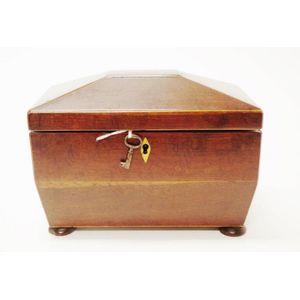Regency Tea Caddy with Boxwood Stringing and Twin Lids
Regency casuarina tea caddy sarcophagus shape, with boxwood stringing and twin matching lidded inner sections, key available, circa 1830s, width 20 cm.
You must be a subscriber, and be logged in to view price and dealer details.
Subscribe Now to view actual auction price for this item
When you subscribe, you have the option of setting the currency in which to display prices to $Au, $US, $NZ or Stg.
This item has been sold, and the description, image and price are for reference purposes only.
- Regency Period - The Regency period in English furniture design refers to the period when King George III, was declared unfit to rule in 1811, and his son ruled as proxy as Prince Regent, until 1820, and then, after the death of his father as George IV until his death in 1830. The Regency period was preceded by the Georgian period (George I, George II, and George III: 1714 - 1811), and was followed by the William IV period, which only lasted until 1837 when William IV died as was succeeded by Queen Victoria.
- Boxwood - Boxwood is a hard, yellow coloured, close grained timber. In the 19th century it was often used for inlays, especially stringing, because of its contrasting colour to the darker timbers of the carcase. Stringing is the inlay of a narrow strip of veneer of a lighter colour, such as boxwood along or close to the edges of an object that has been veneered in a darker timber such as mahogany.
Because of its fine grain and resistnce to splitting or chipping it has also been used for treen, turnings, carvings and other small wooden items, such as chess pieces. - Circa - A Latin term meaning 'about', often used in the antique trade to give an approximate date for the piece, usually considered to be five years on either side of the circa year. Thus, circa 1900 means the piece was made about 1900, probably between 1895 and 1905. The expression is sometimes abbreviated to c.1900.
- Casuarina - Casuarina, is also known as beefwood (because of its appearance) she-oak, swamp oak, river oak, forest oak and Botany Bay wood. It is a native Australian hardwood, red brown in colour with dark flecks.
This item has been included into following indexes:
